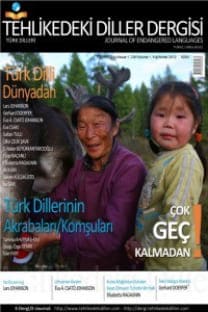О РЕЛИКТЕ КУЛЬТА ГОР У БАШКИР
Bu makale, Başkurtların İslamiyet’ten önceki dönemde inanç dünyasının unsurlarından olan dağ kültü (dağlara tapınma) hakkındadır. Makalede, bu kültün Güney Ural’da doğan ve hâlâ orada yaşayan halk üzerindeki etnik özellikleri incelenmektedir. Belli bir düzenle kurulan piramitler, sütun şeklindeki karaskı denilen yapılar, Başkurtlardaki dağ kültünün maddî yansımasıdır. Bu taş yapılar, Başkurtlar için sahayı kutsallaştırma hizmetini görmüş ve onların, “Dünya dağı” tipinde cisimleşen Evren hakkındaki mitolojik görüşlerini tasvir etmiştir. Başlangıçta bütün Türk soylu halklarda kutsal dağ anlamına gelen “Iyık” kelimesi esasında meydana gelen Güney Ural’daki birçok toponim Başkurtlarda dağ kültü olduğunu göstermektedir. Makalede, Başkurt karaskılarının ve Avrasya’nın birçok Türk soylu halklarında ve Moğollardaki benzer taş yapıların etimolojik ve semantik bakımdan yakın ve hatta aynı oldukları ortaya çıkmıştır.
Anahtar Kelimeler:
Dağa tapınma (dağ kültü), Başkurtların İslamiyet öncesi önceki dünya görüşü, karaskı
ON THE MOUNTAIN WORSHIP OF BASHKIR PEOPLE
The article is dedicated to one of the relicts of the Bashkirs’ pre-Islamic world-outlook – the cult of mountains. In the work there are considered ethnic specifics of this cult among this nation, which has been formed and is living up to now in the South Urals. As a material reverberation of the cult of mountains among Bashkirs there became karasky – a construction of stones in the shape of pyramids, pillars, piled up in a definite order. These stone constructions of Bashkirs served as the way of sacralization of the space and reflected their mythological images about the Universe, personified in the image of “World Mountains”. At the presence of the cult of mountains among the Bashkirs there specify numerous toponyms on the territory of the South Urals on the base of the word Yjyk, which firstly meant among all the Turkic people sacred mountain. In the conclusion there is given an inference about etymological and semantic proximity and even identity of Bashkirs’ karaksy and similar stone structures among many Turkic and Mongolian people of Eurasia.
Keywords:
Cult of mountains pre-Islamic outlook of the Bashkir people, a picture (model) of the world, karasky,
- Başlangıç: 2012
- Yayıncı: Ülkü ÇELİK ŞAVK
Sayıdaki Diğer Makaleler
BAŞKURTÇADA [Ş] ÖNSESİNİN MEYDANA GELME SORUNU
ӘХМӘТЗӘКИ ВӘЛИДИ ТУҒАН ТУЫТУЫНA 125 ЙЫЛ
GELENEKSEL SÜREKLİLİĞE KATKI BAĞLAMINDA BİR KÜLTÜR TAŞIYICISI OLARAK YESEVİ SANAT TOPLULUĞU
KIPÇAK GRUBUNDAKİ DİLLERDE ORTAK ANTROPONİM YAPIM ESASLARI VE ULUSAL NİTELİKLERİ
BARGAZİN EVENKİ HALKI VE DİLİ ÜZERİNDEKİ BURYAT ETKİSİ
